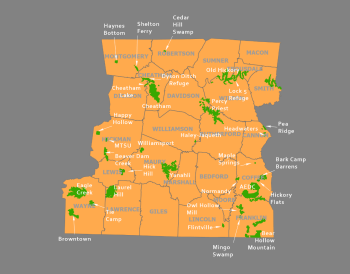Williamsport WMA
Directions and Description
Directions: From Columbia, take Hwy. 50 for 10 miles toward Centerville, after you cross the Duck River at Williamsport the entrance to the area will be marked with a large sign. The entrance road is a hard right Akin Ridge Road is also there, but it is straight as you make the right turn off of Hwy. 50. Lat-Long: 35.707998, -87.229902, Hwy 50 and Akin Ridge Rd intersection Lat-Long: 35.707763, -87.217575, the intersection in the middle of WMA between several ponds
The WMA is open year-round during daylight hours, with access dependent on hunting seasons. License fees may apply. You can stop by the concessioner building check the regulations, and buy fishing supplies, bait, drinks, and food. The building closes in the fall for the winter and reopens in the spring just in time for the fishing season.
Camping is not allowed at any time during the year.
TWRA Contact Information: Region 2 Office: 1-615-781-6622, Toll-Free: 1-800-624-7406, E-mail the office, TWRA Area Manager: Tommy Edwards 1-931-840-4042
Description: Williamsport Lakes was transferred to the Tennessee Wildlife Resources Agency from Occidental Chemical Corporation in the Fall of 1997. The area totals 1,800 acres and is comprised of 4 fishing lakes and 2 wetlands.
Occidental mined phosphorus from the surrounding land and used the lakes as settling ponds for the mud they washed off the phosphorus rocks. The fishing is outstanding as a trophy bass lake in which a size limit of 20 inches on largemouth bass is in place. Springtime is good for shellcracker and bluegill. These lakes range in size from 80 acres down to 12 acres. There is one family fishing lake where it is required to have a child fishing at the age of 16 and under.
Hunting is excellent at Williamsport Lakes also. Typically, sportsmen will harvest around 50 deer each year and at least a dozen wild turkeys. This WMA is also noted for its bird species. Ducks such as mallards, gadwall, and ring-neck ducks will often be found on the fishing lakes during migration. Ring-billed gulls, common loons, and other migratory birds will stop to rest and feed on the larger Blue Cat Lake.
Regulations & Dates
Special Use - No riding during scheduled Big Game hunts. Hooved animal riding, bicycling, and Off-Highway Vehicle (OHV) use is permitted only by individuals possessing a valid hunting and fishing license and WMA permit or a High Impact Habitat Conservation Permit.
Open one (1) hour before sunrise until one (1) hour after sunset on quota hunt days. No camping allowed.
Big Game, Small Game, and Trapping - Same as statewide seasons, except big game seasons have specific dates and closed thereafter. Small game hunting closed at sunset the day before and during big game hunts. Night hunting is not allowed. Closed to Fall Turkey hunting. Closed to Watefowl hunting.
Deer (Archery) - Sept. 27 – Oct. 17, 2025. Statewide bag limit. The access gate closed 1 hour after sunset.
Deer (Gun - Young Sportsman) - Oct. 18–19, 2025. Two (2) deer, only one (1) can be antlered (bonus deer).
Deer (Gun - Young Sportsman) - Oct. 25–26, 2025. Two (2) deer, only one (1) can be antlered (bonus deer).
Deer (Muzzleloader) - Nov. 1–3, 2025. Hunter quota 100. Two (2) deer, but only one (1) can be antlered (bonus deer).
Deer (Gun) - Nov. 22-24, 2025. Hunter quota 100. Two (2) deer, but only one (1) can be antlered (bonus deer).
Deer (Gun) - Nov. 29 - Dec. 1, 2025. Hunter quota 100. Two (2) deer, but only one (1) can be antlered (bonus deer).
Deer (Gun) - Dec. 6-8, 2025. Hunter quota 100. Two (2) deer, but only one (1) can be antlered (bonus deer).
Deer (Gun) - Dec. 13-15, 2025. Hunter quota 100. Two (2) deer, but only one (1) can be antlered (bonus deer).
Spring Turkey (Young Sportsman) - Same as statewide season. One (1) male bearded turkey.
Spring Turkey - April 11 - 24, 2026. One (1) male bearded turkey.
Dog training - Sept. 1, 2025 - March 15, 2026, daylight hours only.











